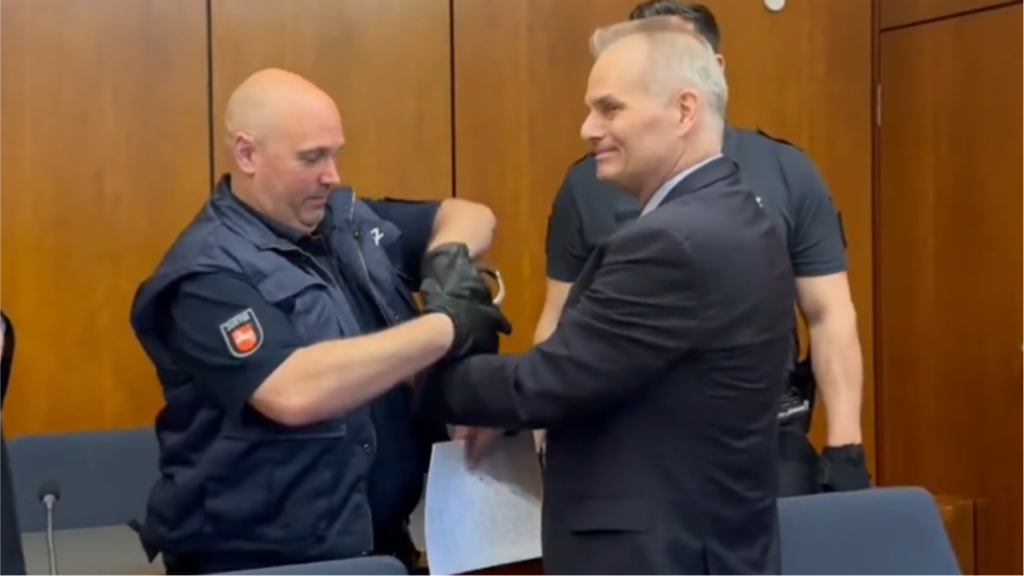Conclave frontrunner Cardinal Aveline’s views on Judaism subvert Church teaching – LifeSite
(LifeSiteNews) — Cardinal Jean-Marc Aveline is now considered a leading candidate to succeed Francis at the coming conclave. Vatican insiders have told LifeSiteNews that he “will be the next pope,” and Edward Pentin and Diana Montagna’s Cardinalium Collegii Recensio states that he is “allegedly Pope Francis’ ‘favorite’ cardinal to succeed him.”[1]
Thus, understanding Aveline’s theology has become an urgent task. In the first three parts of this series we examined how Aveline systematically reinterprets the Catholic religion.
- Part I: He reimagines the role of false religions in salvation.
- Part II: He redefines the universality of Christ’s mediation to include those outside the Church.
- Part III: He reconfigures the Church’s mission around dialogue, rather than conversion.
Each of these moves represents an inversion of Catholic doctrine. Taken together, they constitute a system of apostasy. In place of the true religion, Aveline installs a new model which retains some of the vocabulary of Catholicism, while emptying it of its content. It speaks of Christ, the Church, and salvation—but reinterprets each in the image of modernity, grounded not in revelation, but in sentiment and politics.
These two final parts turn from theory to practice. We will examine how Aveline applies his synthesis to two concrete cases: Judaism and Islam. We will see that Aveline systematically exploits the Jewish people in a program of theological subversion, which follows these clear steps:
- Misrepresent the Mosaic Covenant as being of ongoing validity
- Misrepresent Judaism as the continuation of the Mosaic religion
- Create a false understanding of the Church’s relationship with Rabbinic Judaism
- Use this false understanding to “deepen” what he calls “the mystery of the differentiated unity of God’s work”
- Use this “mystery of the differentiated unity” as the lens through which to understand other non-Christian religions, and thus explain how they retain “salvific or revelatory value.”
The final step of Aveline’s program explains how he justifies saying that “[b]asically, religions are ways for men and women to seek answers to the great, simple questions of life”—which represents the collapse of his whole synthesis into naturalism, and apostasy from Christ.
In this part, we will see how his treatment of Judaism becomes the camel’s nose beneath the tent: he quietly subverts the Church’s settled doctrine with regards to Judaism, only to extend this subversion to all religions through the synthesis we have been analyzing.
After addressing his approach to Judaism—most of which will be drawn from his 2010 article “Les enjeux actuels des relations entre juifs et chrétiens” (The current issues in Jewish-Christian relations)—we will demonstrate the application of his method to Islam, which will stand in as a representative for the various other non-Christian religions.
Aveline’s approach to Judaism, and subsequently to other religions, exposes the final logic of his vision: a Church that renounces her mission to convert all nations, and instead, takes her place sitting at the feet of Judaism and other non-Christian religions.
If the Church were to do this, she would deny her very identity as the Church of Jesus Christ.
I. WHAT DO WE MEAN BY ‘JUDAISM’?
We begin, by considering the nature of Judaism—the keystone of Aveline’s religious vision, and the foundation of his new theological order.
We must state plainly: Judaism, as we know it today, is not the true religion: it is a false religion. It cannot be treated as a form, variation or continuation of the true religion revealed by God to the patriarchs and prophets.
As some readers may find this surprising, we must review the key points of doctrine and history.
Has the Old Covenant been revoked?
First: the Mosaic Covenant was fulfilled and brought to its end by Christ. From the moment of his Passion and Resurrection, salvation has been available only through faith in him and membership in his Church. As such, the Old Covenant no longer functions as a salvific path for anyone. It has been fulfilled, just as the caterpillar is fulfilled in the butterfly.
There is no “dual covenant” or separate dispensation for Jews without Christ or the Gentiles; there is one Redeemer, one Church, one path to salvation and one Covenant for all men, regardless of race. To deny this is to contradict divine revelation and the solemn, unanimous voice of the Fathers, Popes, and Councils.
We have explained this at greater length in an article accompanying this series.
Is Judaism the Mosaic religion?
Second: the religion known as “Judaism” today is not even a continuation of the Old Testament religion without Christ.
Many Jews accepted Christ as the Messias. However, most Jews did not accept him, and continued to practice the Mosaic religion without regard for him.[2] However, this Mosaic religion—centered on the Temple, the Levitical priesthood, and animal sacrifice—ceased to exist in 70 AD with the prophesied destruction of the Temple and the Fall of Jerusalem.
What remains today is a new religion, known as Rabbinic Judaism. This system was reconstituted, in great part in the ancient town of Yavne (Jamnia). This reconstitution was based not on the rites and sacrifices of Moses, but on the teaching of the rabbis and the “sages”—the religious teachers and respected rabbis who flourished roughly between 250 BC and 625 AD.
Few Christians today realize that these rabbis and sages were decisively influenced by the great opponents of Christ himself—the sect of the Pharisees. The Jewish Encyclopedia (1906) is clear on this link between the Pharisees and the Jews.
[W]ith the destruction of the Temple the Sadducees disappeared altogether, leaving the regulation of all Jewish affairs in the hands of the Pharisees.
Henceforth Jewish life was regulated by the teachings of the Pharisees; the whole history of Judaism was reconstructed from the Pharisaic point of view […]
Pharisaism shaped the character of Judaism and the life and thought of the Jew for all the future.[3]
The Universal Jewish Encyclopedia (1941–43) confirms the same:
The Jewish religion as it is today traces its descent, without a break, through all the centuries, from the Pharisees.[4]
While not all the “Sages” were Pharisees in the strict sense, the dominant stream of Rabbinic thought, and the interpretive framework and assumptions of post-Temple Judaism, were deeply and self-consciously shaped by the Pharisaic traditions, and continued the Pharisee’s opposition to Jesus of Nazareth and the Christian Church.
We have explained the Pharisaic roots of Rabbinic Judaism at greater length and with greater nuance in another accompanying piece.
In short: Rabbinic Judaism is a man-made religion, formed after Christ, against Christ, outside of the fulfilled Mosaic Covenant and in rejection of the New Covenant.
Does Rabbinic Judaism have a divine vocation in the world?
Given this Pharisaic heritage, it is not surprising that the Church Fathers, Popes, and Doctors did not speak of an ongoing supernatural vocation or mission for the unconverted Jewish people. The closest that Catholic authorities have come to such an idea is recognizing that, by being scattered among the nations, Rabbinic Jews have served as an unintended witness to the truth of Christian prophecy. As St. Augustine writes:
[The Jews] are thus by their own Scriptures a testimony to us that we have not forged the prophecies about Christ. (City of God XVIII.46)
This is also addressed at greater length elsewhere.
With this essential background, we can now explore Cardinal Aveline’s claims, and expose the blasphemous inversion at the heart of his religious vision.
II. AVELINE’S APPROACH TO JUDAISM
When Francis visited Marseille, Aveline arranged the trip around the schedule of the Jewish leaders.[5] But there is much more to Aveline’s relationship with Judaism than diplomacy or logistics.
As in his approach to Islam and other religions, Aveline employs a method of problematization: he casts suspicion on tradition, dissolves doctrinal certainties, and inverts the presumed positions of truth and error.
Is the relationship between the Church and the Jewish people a doctrinal blank canvas?
Aveline begins with a bold claim:
No document from the Catholic magisterium has expressed a doctrinal judgment on the relationship between the Church and the Jewish people.[6]
This is false. There have been doctrinal judgments on matters pertaining to this relationship; and while they may not explicitly address the post-Christian Jewish people as a sociological collective, the Church’s magisterium has clearly judged matters which determine their theological standing: fulfillment of the Mosaic Covenant, the abrogation of the Old Law, and the non-salvific character of Rabbinic Judaism.[7]
The Church’s theological understanding of this relationship has always followed from these points.
Second, Aveline’s tactic—treating a lack of solemn declarations on a sociological concept as a license for innovation—is based on a flawed methodology.
It is a condemned error to claim that Catholics are bound only to doctrinal judgments—by which we understand Aveline to mean specific acts and decrees—as if the Church’s magisterium was not also exercised in a “universal and ordinary” way, through the continuous witness in the Fathers, the doctors, her liturgy and her disciplinary tradition.[8]
The Church’s judgment regarding the Jewish people has also been adequately expressed in this way, including in the consistent orientation of the Sicut Judaeis bulls.
Aveline’s presentation of the Church
However, Aveline ignores the significance of this witness, and instead presents it as part of a sweeping narrative of ecclesial guilt and irrational hatred.
In the supposed absence of doctrinal clarity which he alleges, he claims that the Church cultivated a “grassroots” hostility to the Jews. In keeping with his apparent rejection of a “Church of Anathemas” (discussed previously) Aveline casts the Church in a very negative light, portraying her as fostering an irrational and unprovoked contempt for Jews. He writes:
For centuries, Christian apologetics had lent its approval to recurring movements, whether pagan in origin, of hatred and persecution towards the Jewish people.[9]
Elsewhere, he characterizes the Church’s attitude as one of contempt and pathological ambivalence:
Regarding Judaism, the Church seems to have been inhabited by two contradictory feelings: triumphalism on the one hand, in the sense that the abasement, servitude, and humiliation of the Jewish people were seen as proof of its victory; and anxiety on the other hand, with regard to a difference perceived as persistent, irreducible, and ultimately dangerous. Many writings of the Church Fathers betray this ambivalence.[10]
Aveline accuses the Fathers—St. John Chrysostom, St. Ambrose, and St. Augustine—as well as the popes of the Counter-Reformation, of sustaining a “teaching of contempt.”[11] He claims that Christendom was, until recently, “regularly tempted” to eradicate the Jewish people.[12] He accuses a “significant portion of Catholic opinion” in the late nineteenth century of embracing and encouraging anti-Semitism.[13] Aveline also expressed critical views of twentieth century popes, for failing to teach his ideas about the Church’s supposed links with Jewish people—without pausing to consider whether this reflects badly on those popes, or Aveline himself.[14]
In short: Aveline judges the Fathers and Catholic authorities with severity, suggesting that it was this theological contempt that was adopted and “pushed to the extreme” by Nazi ideology. His implication is clear: the Church is responsible, whether by act or by omission, for genocide.
His contrasting treatment of Rabbinic Judaism
Aveline’s treatment of Jewish authorities is starkly different.
While condemning the Fathers and Catholic authorities for their writings about the Jewish people, he praises “the Sages of Israel”—for the supposed “spiritual vitality” of Rabbinic Judaism and its Talmudic tradition. In so doing, he glosses over the profound theological rupture between the Church and post-Christian Judaism—an opposition recognized not only by both Fathers and the Sages themselves, but also by Christ. He writes:
The first [area of future study] concerns the relationship between the Church Fathers and the Sages of Israel, that is, between, on the one hand, the considerable work of biblical hermeneutics undertaken by early Christian patristic literature and, on the other hand, the incredible spiritual vitality with which the Jewish people managed to transform the catastrophes of the first century (with its two fateful dates of 70 and 135) into the foundation of a new hermeneutical construction, the Talmud, capable of maintaining Jewish identity and bearing fruit, even in the worst situations of exile, dispersion, and persecution.[15]
At first glance, this may seem harmless, and such comparative study might even yield useful academic insights.
But to present the Rabbinic Sages as bearers of “spiritual vitality,” while castigating the Fathers for their “triumphalism” or even implicating them in genocide, is a profound theological inversion.
This is simply to elevate the heirs of the Pharisees, while denouncing the heirs of the Apostles—a betrayal not only of the Fathers, but of Christ himself.
The Mosaic Covenant as the ‘fundamental link’
How is such an inversion possible? At the root of Aveline’s approach is the claim that the Old Covenant “has never been denounced” (viz. abrogated), and his presumption that Rabbinic Judaism is simply the continuation of the Mosaic religion, without Christ.[16]
As we have already discussed elsewhere, this claim is contrary to the Church’s magisterial tradition and to history. However, Aveline presents these false ideas as being vital for understanding the true relationship between the Church and Judaism.
He writes that the supposed validity of the Mosaic Covenant means that Christian theology must move beyond what he calls “the categories of ‘substitution’ or ‘fulfillment’ [as] the only ways of expressing the relationship between the Church and the Synagogue.”[17]
Based on this, he countenances the following questions:
- Did the Old Testament necessarily lead to the recognition of Jesus as the Christ?
- Could one remain faithful to the Old Covenant without becoming Christian?[18]
This prepares the way for a pivotal (and misleading) claim, which he has voiced on more than one occasion:
If the Christian faith confesses that Christ is the fulfillment of the Scriptures, it cannot deduce from this that Christianity is the fulfilment of Judaism![19]
However, Catholic teaching certainly does not claim that Christianity fulfills Rabbinic Judaism—a religious system erected after Christ, in explicit rejection of him, by the heirs of those whom he opposed during his ministry.
On the contrary, Catholic teaching does hold that the Church fulfills the pre-Christian religion of the patriarchs and prophets—a distinction masked by Aveline’s formulations.
By separating Christ’s fulfillment of the Scriptures from his misleading concept of the “fulfillment of Judaism,” Aveline shields Rabbinic Judaism from the judgment that it is a false, man-made system which has departed from divine revelation. He thus opens the way for the so-called “dual-covenant theology,” in which Aveline can claim that Judaism retains a valid, ongoing role in salvation history apart from the Church—even if such an idea is made palatable to the unsuspecting through the vague and universalizing notion of “christic mediation.”
In this way, Aveline’s reinterpretation does not merely nuance the Church teaching: it denies its foundational claims to represent “the New and Eternal Covenant,” and attributes salvific value and ongoing validity to a system that explicitly rejects Christ.
Aveline thus replaces the Church which fulfills the Old Covenant, with one which coexists alongside it and dialogues with it—no longer missionary, no longer definitive, no longer claiming to possess the one truth to which all men must submit.
In light of his commitment to such ideas, we can see why Aveline referred to the thrice-defined dogma “Outside the Church there is no salvation” as an “ancient Patristic adage” which has been subject to “a hardened, and thus distorted, interpretation.”[20] One cannot hold both this dogma and Aveline’s ideas.
Aveline’s view of the links between Jews and Christians
He describes “the irreducible uniqueness of the Jewish-Christian relationship,” and writes:
From the perspective of the Christian faith, Judaism will never be a religion like any other.[21]
Aveline invests this truism with a theological weight that far exceeds the facts. He claims, based on his misrepresentations discussed, that the Church has retained deep spiritual bonds with Judaism and the Jewish people—bonds so deep that misunderstanding her relationship with Rabbinic Judaism prevents the Church from truly understanding herself.[22]
Aveline affirms that dialogue between Christians and Rabbinic Jews was intended “to make more solid the bonds that unite us and continue walking together the path of reconciliation and fraternity.”[23]
As mentioned above, he criticized Pope Pius XI and Pope Pius XII for having failed to articulate what he sees as the Church’s “true” relationship with the Jews. He describes these bonds as:
[T]he fundamental link that spiritually connects the people of the New Testament with the lineage of Abraham.[24]
More revealingly still, he writes:
For what unites us, Jews and Christians, what we live in the secrecy of our hearts or in the expression of our liturgies, is radically more important than what separates us.[25]
Such a statement would be firmly rejected by many religious Jews. However, far from being a meaningless platitude, this reveals Aveline’s presuppositions. It presumes a kind of mystical convergence between the Church and Rabbinic Judaism—one that places shared religious experience above revealed truth.
In this framework, the person of Jesus Christ fades into the background—dissolved into the “christic mediation” discussed previously—and replaces dogmatic claims with “spiritual links.”
The implication is that both Christianity and Rabbinic Judaism are positively willed by God; that the adherents of both religions have supernatural faith; and that both religions continue to have a divine purpose in the world today. In effect, Christianity and Rabbinic Judaism are both “true religions.”
What does this paradigm mean for the Church and the idea that the pre-Christian religion of the Jewish people has already been fulfilled in Christ and perpetuated in the Church?
Aveline’s attribution of a ‘vocation’ and ‘mission’ to Rabbinic Judaism
Aveline is explicit: Rabbinic Judaism does have a purpose: indeed, he argues that it has a vocation and a mission, and that it is the Church’s responsibility to affirm both. He tacitly excludes the traditional understanding of non-Christian religions, namely that God permits their existence for the sake of higher goods.
Instead, Aveline evidently considers Rabbinic Judaism to be positively willed by God. He speaks of the “vocations” of Christianity and of Judaism—treating these vocations as comparable—and claims that interreligious dialogue has led to the following, desirable result:
[E]ach community’s perception of the vocation that is theirs and that each discovers gradually can only be understood by accepting that it was received in shared communion with the other, not in an exclusive manner.[26]
In light of what we have already seen, the notion that the Church received her “vocation” in “shared communion” with Rabbinic Judaism, and that she can only understand this vocation gradually by accepting this alleged fact, is absurd.
Further, a vocation is a calling to a particular purpose, usually noble or even spiritual. We must therefore also ask: Who exactly has called Rabbinic Judaism—and to what purpose or vocation, exactly?
Aveline cites Cardinal Ratzinger, who poses a question that assumes the same ideas he expresses:
Is the Christian faith, if we allow it its inner requirement and dignity, capable not only of tolerating Judaism but, more importantly, of accepting it in its historical mission?[27]
But again, what “historical mission” could Rabbinic Judaism, the legacy of the Pharisees, possibly have after the coming of Christ, the fulfillment of the Covenant and the abrogation of the Mosaic Law?
It is clear what “historical mission” Aveline does not have in mind—he is not referring to the role which St. Thomas Aquinas and other Catholic authorities ascribe to the Jews, namely that of bearing witness to the truth of Christ in spite of themselves.[28]
In fact, Aveline takes such ideas and distorts them. Instead of being the unintentional witnesses to the Gospel that they deny, he claims something very different: that Rabbinic Judaism has a divine vocation to help the Church understand herself.
Aveline and the ‘purification’ of the Church by Rabbinic Judaism
Aveline urges that the Church must begin by “looking at Judaism differently’ and “receiving it as it understands itself”—including its understanding of its history and “vocation.”[29] For this greater understanding, he says, the Church “can invite [Christians] to seek […] the spiritual links that unite them to [Rabbinic Judaism].”[30]
Because Aveline treats Rabbinic Judaism as the continuation of the Old Testament religion, and as an enduring Covenant with God, its relationship with the Church becomes “asymmetrical”:
[A]n asymmetry seems to remain: the Church needs to think theologically about its relationship with Judaism in order to understand itself, which is not the case for Judaism.[31]
He continues, insisting that Christians must reflect on the relationship “as it exists today,” specifically as informed by two thousand years of “Talmudic work,” independent from and opposed to Jesus Christ:
[W]hat is required is a theological reflection on the relationship between Christianity and Judaism as it exists today, carrying with it a long mystical and theological reflection developed over two millennia based on the Talmudic work.[32]
The idea that the Church must revise her self-understanding to accommodate modern Jewish perspectives about Rabbinic Judaism is, to say the least, highly suspect.
This asymmetry is a form of dependence: the Church needs Judaism—both to know the Jews, and to know herself; but Judaism does not need the Church.
This has radical implications for the Church and her doctrine. The enormous extent of what Aveline is attempting becomes clear in his citation of Cardinal Ratzinger’s claim about other religions in general:
The world’s religions have become a question addressed to Christianity, which must, in their presence, reconsider its claim and thus receive from them, at the very least, a service of purification.[33]
This is the supposed vocation and mission of Rabbinic Judaism: to purify the Church, by revealing and teaching her a greater understanding of herself.
Conclusion
Thus we arrive at the final perversion at the heart of Aveline’s theology. His vision strips the Church of her divine mission and enthrones Rabbinic Judaism as her tutor and judge.
Despite the “asymmetry” mentioned, Aveline claims that there is also an increasing reciprocity on the side of Rabbinic Judaism. He then adds this ode to religious indifferentism:
The patient and demanding dialogue that we are called to build from our respective fidelities to different faith standards is itself part of what we confess as the ‘history of salvation.’
It makes us, in a sense, responsible for the quality of the other’s response to the call of God that he or she has received in his or her own way.
The differences remain, but they are shared, in a mutual call that is an emulation in the sense that Saint Paul already envisioned between Jews and Gentiles in the Epistle to the Romans.[34]
However, as we can see in the text above, the Christian’s duty (in Aveline’s view) is not to convert the Jewish person—but to be co-responsible for helping him be more faithfully Jewish. In return, the Jewish person is to help the Christian be more fully Christian.
Thus the Church of Christ is to become not merely a fellow traveler, but even a disciple of Rabbinic Judaism, seeking a wisdom beyond “the faith once delivered to the saints.” (Jude 1.3)
Where will this end? With Rabbi Elijah Benamozegh’s kindly plan to reform Christianity along rabbinic lines, by purifying it of the “new mythology” of the Trinity and the “the problematic personage of Jesus” himself?[35] In some ways, Aveline has already achieved this “dissolution of Jesus” (1 John 4) through his subversion of Christ’s role as mediator.
In itself, Aveline’s approach to Judaism is an appalling theological inversion. However, he does not stop at subjecting the Church to Rabbinic Judaism: he takes this method of inversion and extends it to all religions, erecting a universal apostasy.
He specifically claims that his treatment of Judaism can “help” the Church by serving as the model for his wider theology of religious pluralism. By adopting his account of the relationship between the Church and Rabbinic Judaism, Aveline introduces a method that can then be applied to Islam, Hinduism, and every other religion.
[T]he experience of interreligious encounter can enable a theology of the Jewish-Christian relationship to deepen the mystery of the differentiated unity of God’s work, in the form of a call to share the gifts that each (Jew, Christian, and “other”) has received in service of the Promise made in Abraham to all the human family.[36]
In fact, he not only assumes that his erroneous method can be applied to Judaism and other religions: he even suggests that this is obligatory:
[R]eligious pluralism compels each religion to rethink the relevance of its claim to universality.[37]
It is to this final catastrophe—the application to Islam and every false religion of what Aveline has “learnt” from Rabbinic Judaism, culminating in the dissolution of the Church into a naturalistic religion of man disguised under the name of Christ—that we now turn.










